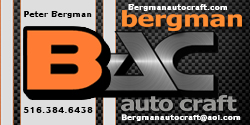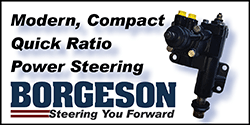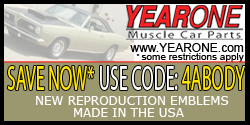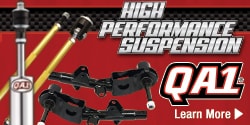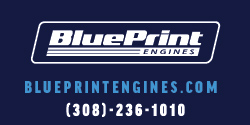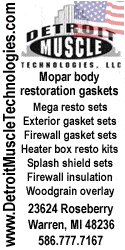Maybe some of them do. The way that both valve reliefs are the same size was a surprise to me.
You are using an out of date browser. It may not display this or other websites correctly.
You should upgrade or use an alternative browser.
You should upgrade or use an alternative browser.
The 360 build that has more turns than Willow Springs
- Thread starter Kern Dog
- Start date
-
I know that I have stated this a couple of times but it has been awhile since I’ve assembled a stock LA series engine. When you do something often enough, you just know things and don’t have as many hiccups in the build.

I called my machinist to remind me…. The notches in the big ends of the rods face OUTSIDE toward the oil pan rail.

With the pistons facing with the valve reliefs UP like so…

The chamfer in the big ends will need to be to the LEFT for all 8 rods.

The left side faces the fillet/counterweight. The right side will meet another rod on the crank pin and so the rod is almost flush with very little chamfer.

You can see better with a bearing in place. Note how the bearing below is tucked in a bit in this photo…

Then almost flush in this photo….

Many guys already knew this. Once I’m back doing this stuff it comes back to me. Having the pistons symmetrical does make it easier.

Next will be to file fit the rings. These KB Hypereutectic slugs have an unusual spec….

Really??? A .0065 gap factor means 4.040 X .0065. That is a .026 ring gap. That really seems wide but there it is as they call for.

The last section above shows a more common .004 factor for the second ring. That is approximately .016”. I have this weird memory of a set of pistons I had some time ago that called for a second ring with a bigger gap than the top. Did I just imagine that??
Onward….
I called my machinist to remind me…. The notches in the big ends of the rods face OUTSIDE toward the oil pan rail.
With the pistons facing with the valve reliefs UP like so…
The chamfer in the big ends will need to be to the LEFT for all 8 rods.
The left side faces the fillet/counterweight. The right side will meet another rod on the crank pin and so the rod is almost flush with very little chamfer.
You can see better with a bearing in place. Note how the bearing below is tucked in a bit in this photo…
Then almost flush in this photo….
Many guys already knew this. Once I’m back doing this stuff it comes back to me. Having the pistons symmetrical does make it easier.
Next will be to file fit the rings. These KB Hypereutectic slugs have an unusual spec….
Really??? A .0065 gap factor means 4.040 X .0065. That is a .026 ring gap. That really seems wide but there it is as they call for.
The last section above shows a more common .004 factor for the second ring. That is approximately .016”. I have this weird memory of a set of pistons I had some time ago that called for a second ring with a bigger gap than the top. Did I just imagine that??
Onward….
'67 - 91 318's came with 273 mechanical rockers??
I know that I have stated this a couple of times but it has been awhile since I’ve assembled a stock LA series engine. When you do something often enough, you just know things and don’t have as many hiccups in the build.
View attachment 1716393146
I called my machinist to remind me…. The notches in the big ends of the rods face OUTSIDE toward the oil pan rail.
View attachment 1716393148
With the pistons facing with the valve reliefs UP like so…
View attachment 1716393149
The chamfer in the big ends will need to be to the LEFT for all 8 rods.
View attachment 1716393150
The left side faces the fillet/counterweight. The right side will meet another rod on the crank pin and so the rod is almost flush with very little chamfer.
View attachment 1716393151
You can see better with a bearing in place. Note how the bearing below is tucked in a bit in this photo…
View attachment 1716393152
Then almost flush in this photo….
View attachment 1716393153
Many guys already knew this. Once I’m back doing this stuff it comes back to me. Having the pistons symmetrical does make it easier.
View attachment 1716393156
Next will be to file fit the rings. These KB Hypereutectic slugs have an unusual spec….
View attachment 1716393157
Really??? A .0065 gap factor means 4.040 X .0065. That is a .026 ring gap. That really seems wide but there it is as they call for.
View attachment 1716393158
The last section above shows a more common .004 factor for the second ring. That is approximately .016”. I have this weird memory of a set of pistons I had some time ago that called for a second ring with a bigger gap than the top. Did I just imagine that??
Onward….
Absolutely gap the rings as wide or wider than KB says. Any tighter and you'll be rebuilding again.
I went a strong .025 ++ with the top rings. #7 went a bit over.....030. All the second rings are between .016 and .017.
One thing I am expecting is trouble with the fuel pump eccentric. The prior owner of this engine had a blockoff plate where the fuel pump attaches. I should have taken pictures during disassembly, especially where the cam sprocket bolt attaches. Hughes has this:

As always, their prices are not cheap but at least their stuff is always great quality.
As always, their prices are not cheap but at least their stuff is always great quality.
Bobzilla
Well-Known Member
No need to fear those adapters. We have one in use for a lot of street miles and years. I file the key slightly so it fits nice and then during final assembly use RED loctite and torque properly.One thing I am expecting is trouble with the fuel pump eccentric. The prior owner of this engine had a blockoff plate where the fuel pump attaches. I should have taken pictures during disassembly, especially where the cam sprocket bolt attaches. Hughes has this:
View attachment 1716393263
As always, their prices are not cheap but at least their stuff is always great quality.
mopowers
Well-Known Member
Didn't you say your camshaft had the longer snout? I can't recall.One thing I am expecting is trouble with the fuel pump eccentric. The prior owner of this engine had a blockoff plate where the fuel pump attaches. I should have taken pictures during disassembly, especially where the cam sprocket bolt attaches. Hughes has this:
View attachment 1716393263
As always, their prices are not cheap but at least their stuff is always great quality.
I don’t know. I have a new in box flat tappet cam that I can lay alongside this roller cam to determine that. This cam had some woodruff key and collar along with the retaining bolt.
mopowers
Well-Known Member
I think you said your cam is from Hughes? I believe most of their hydraulic roller SB cams generally have the longer snout. I'd bet you just need to add a fuel pump eccentric to what you have and be on your way.I don’t know. I have a new in box flat tappet cam that I can lay alongside this roller cam to determine that. This cam had some woodruff key and collar along with the retaining bolt.
Yeah, that would be convenient, but…,


This was on the end of the cam when I pulled it out….

The bolt on the left was in the cam…

This was on the end of the cam when I pulled it out….
The bolt on the left was in the cam…
I should have paid closer attention when I tore down the engine. Here is the timing sprocket on the roller cam. I can see immediately that the cam snout is recessed a bit.

Here is the sprocket on a new flat tappet cam.

There isn’t much sticking out but still enough for the fuel pump eccentric to attach.

It looks like the prior owner did use a Hughes spacer and bolt but why? He had an electric fuel pump….

I do remember losing the woodruff key when I pulled the timing gear off.

Using that spacer, it does look like it would work…

The stock Woodruff key looks like it is almost a half round…

This hybrid thing looks like I’d need a key that looks like this:

You think Hughes would sell just the key? It might make more sense to modify a standard Woodruff key and weld on a nub.
I’ll bet they’d want $20 for just the key….

Here is the sprocket on a new flat tappet cam.
There isn’t much sticking out but still enough for the fuel pump eccentric to attach.
It looks like the prior owner did use a Hughes spacer and bolt but why? He had an electric fuel pump….
I do remember losing the woodruff key when I pulled the timing gear off.
Using that spacer, it does look like it would work…
The stock Woodruff key looks like it is almost a half round…
This hybrid thing looks like I’d need a key that looks like this:
You think Hughes would sell just the key? It might make more sense to modify a standard Woodruff key and weld on a nub.
I’ll bet they’d want $20 for just the key….
I like to go .032" on the top ring with KB pistons.I went a strong .025 ++ with the top rings. #7 went a bit over.....030. All the second rings are between .016 and .017.
mopowers
Well-Known Member
Almost looks like you could get away with using a short piece of regular ol' 3/16" (or whatever size) key stock for the adapter. What would prevent it from falling out though? Would the deep cupped washer encapsulate it?
I could maybe take a standard curved key and weld a flat extension on it. Of course I could file and shape it to size.
OR just make one from one piece of metal with no welds to potentially break. This little dude could take hours to make but hey....that is how it goes with cars sometimes, right?
OR just make one from one piece of metal with no welds to potentially break. This little dude could take hours to make but hey....that is how it goes with cars sometimes, right?
No **** ? That seems huge!I like to go .032" on the top ring with KB pistons.
I guess the downside of a wide gap is additional blow-by but you sure won't be butting the ring ends together.
You could go .100" and never see a difference. I'd rather be safe than sorry on KBs.No **** ? That seems huge!
I guess the downside of a wide gap is additional blow-by but you sure won't be butting the ring ends together.
I don't mean to be rude but that seems hard to believe.
Consider this. Rings rotate as the engine runs. How many times in an engine's life do you think the rings line the gaps up? I don't know either, but it's a LOT. The ring gaps don't give enough time at TDC on compression stroke to bleed much of anything off. The piston is at TDC for such a very short time, ring gaps are almost inconsequential.I don't mean to be rude but that seems hard to believe.
Well heck, I guess I could open up the 7 rings that I got close to the published spec.....I did have one run a bit beyond the listed number.
Just look at what the nitrous and forced induction specs are. I use those on N/A engines. Kinda like a "just in case" margin. Do I know more than they do? Of course not. But here's how I look at it. If you're in the middle of summer sittin in traffic and the engine gets heat soak bad, things tend to go outside of specs. Like ring gaps. Pistons expand a lot.....maybe more than the N/A spec. Who knows? I know I don't. But why take chances? I think the nitrous and forced induction spec is like .007" for every inch of bore if I remember right. Might be more. So if that's the case, there's .028" right there. You think .032" will make a difference? Hardly. You gotta a lotta money in this. I know if I did I wouldn't want to take any chances. All this is my opinion based on the fact that I don't like to take chances. I've seen too many people have issues with KB pistons that "claimed" they had everything right. Did they? Maybe. If they did, that means those pistons expanded more, doesn't it?Well heck, I guess I could open up the 7 rings that I got close to the published spec.....I did have one run a bit beyond the listed number.
Hmmm.....

Yeah. There's some .008s in there. I thought there was. So see? Street N/A is .0065". So .008" AIN'T far off, is it? However, going THE OTHER WAY because of pistons that expand more and closing those gaps UP that same difference.....get where I'm goin?
I am not against taking good advice. I just remember that old suggestion of .004 per inch of bore guideline.
The sheet below came with the rings I used with my 440/495 build in 2022 using Forged Icon quench/dished pistons.

The sheet below came with the rings I used with my 440/495 build in 2022 using Forged Icon quench/dished pistons.
The KB pistons have a really high silicone content compared to other hyper pistons. They expand more. That explains their particular ring gap specs.I am not against taking good advice. I just remember that old suggestion of .004 per inch of bore guideline.
The sheet below came with the rings I used with my 440/495 build in 2022 using Forged Icon quench/dished pistons.
View attachment 1716393721
-
Similar threads
- Replies
- 77
- Views
- 5K
- Replies
- 43
- Views
- 2K
- Replies
- 35
- Views
- 2K
- Replies
- 182
- Views
- 10K



